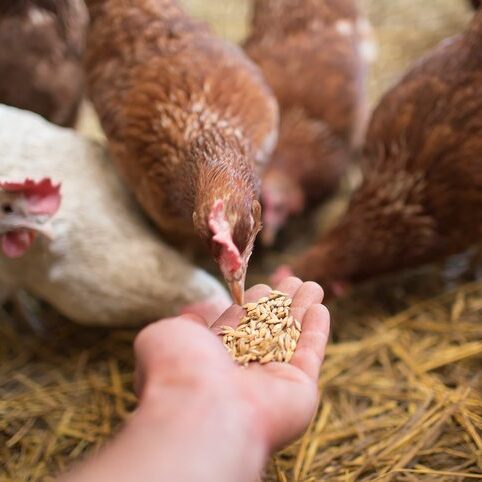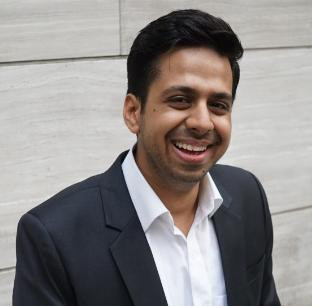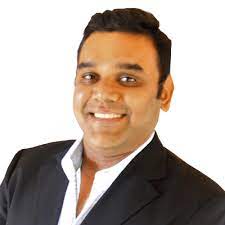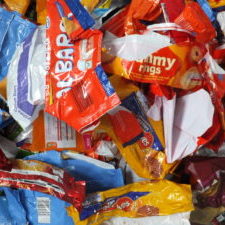The numbers are staggering. India wastes 40% of the food it produces every year. More than 200 million metric tons each year goes unconsumed. Commercial food waste or pre-consumer food waste is over 150 million metric tons each year.
Waste of any kind today is becoming a big business opportunity and many new ventures are springing up. But turning food waste to either animal feed or even human-grade food is a multi-billion dollar opportunity. Technology has been around, but entrepreneurship appetite for it is building up only now.
Set up as recently as 2018, the Gurugram-based Wastelink is already turning hundreds of tons of food waste into animal feed ingredients. Founded by two former colleagues Saket Dave and Krishnan K, Wastelink co-founders believe their company has the potential to become a unicorn – one that truly makes money for all its stakeholders.
Already, the firm’s supplier locations are spread across seven states and 500 brand locations. It has four dedicated facilities for food upcycling, spread over an area of 20K sq. ft. with a processing capacity of 1000 MT per month.
Along with cutting waste, the ecological impact of reuse of food waste is immense. By producing 4,000 MT of animal feed since 2018, the firm says it has prevented 5,000 MT of GHG emissions. Imagine the positive impact if 150 million tonnes of commercial food surplus is converted?
Wastelink has built a tech platform they believe can become a plug-and-play offering for anyone interested in turning food waste into useful products.
In a free-wheeling chat with Benedict Paramanand, Editor of SustainabiltyNext, Saket and Krishnan share their vision and how they are going about building a green enterprise.
Tell us about your early years and what inspired you to enter the waste management business
Saket – I have been in the waste industry since I was 17 and in college. I had been introduced to this area by the IYCN – Indian Youth Climate Network. Back in the day, they were doing fantastic work around solar power automobiles in India. They were a youth driven NGO, volunteer based. Their idea and messaging was amazing and connected with young people like me. I became involved with them and gradually became aware and interested with the global discussion on climate change.
When I was in college, the environmental societies used to suggest planting trees to tackle climate change. I knew this was not going to get us anywhere. I went to the Dean (at Thapar University) and asked for her help. I presented my ideas in waste management and environmental education. She asked me to submit a proposal for my idea – which was about food waste management in the campus (6 hostels, generating tons of food waste annually). She convinced the director for funding, and we became the highest funded student initiative in Thapar. We started getting into waste – researching ways to segregate and handle it, and so on. That is how my interest in this particular field of food waste management started.
I got selected by the British Council as the national climate champion for India, which gave me even more exposure. There, I learnt more about different kinds of wastes and ways to handle them.
For me, the whole idea behind Wastelink was to cater to the large problem of food waste. It is probably the most unsolved opportunity in the waste industry – a lot of work has happened in the plastic waste industry, the electronic waste industry, but perhaps the only work that had been done in the food waste industry was composting. Upcycling food waste and salvaging the good from it was an unsolved challenge, especially for India. Ironically, we also have one of the largest quantities of food waste in the world.
Food waste is a huge opportunity as a business in multiple segments – there’s food-to-feed, which we are doing right now, and there’s food-to-food, which is what we are currently heading towards.
How can more youth be inspired to solve ecological problems?
Saket – as a country, I think we really need to prioritize sectors like sustainability as they are core to our growth. I have often been asked why I chose the waste industry over working in fintech. The whole waste ecosystem has a negative connotation associated with it. Its perception as an unattractive sector needs to change, and that change comes from encouraging young people to find solutions, encouraging governments, universities and schools to nurture minds in such a way. Finding alternative solutions to dealing with what we are wasting is imperative, as reusing and reducing is good, but it is extremely vital that we find new ways to recycle.
Greater sensitization to the waste situation in India will help in attracting more talent and passion to the industry. Having the right kind of support infrastructure in the form of funding, entrepreneurship will automatically come by.
Krishnan – I agree that the ecosystem can and must do more, but I think the most crucial point is that this area badly lacks entrepreneurship and innovation. Not enough of us have actually gone about trying to solve the food waste problem in a serious way, even though there is so much scope. The common solution is composting, which is great; it is fantastic as compared to landfills and other options, but we haven’t moved past that.
Now, with Wastelink and other similar players, we are seeing some very exciting innovations, we are realizing that not all waste is equal. Waste is a colloquial terminology for something that someone doesn’t need. But if someone doesn’t need something, it doesn’t mean that it won’t be useful to somebody else. There is huge value in waste – your waste is my goal. So that nuance is necessary; innovative thinking is necessary. I think Wastelink pioneers this kind of thinking. This ecosystem for entrepreneurs and innovation in the country is starting to develop.
One of the biggest challenges that we see in the food producing world is their ability and willingness to bring about change in the way they handle food waste.
How would you like to become advocates of zero food waste?
Krishnan – For a large part, I think advocacy is built into our business model as we speak to food companies daily. We convince them to repurpose and redirect their food waste to a greater and more environmentally (as well as fiscally) better outcome.
Our tech platform solves several problems for the food producers at the point of origin and further down as we are able to purpose/pay for food waste that is generated, making us a far better alternative for waste handling. From a value point of view, the efficacy of our solution is apparent, and food companies are also faced with this need to bring about a positive change, which is facilitated with our idea.
Does food producing customer earn from his waste?
Krishnan – We believe in sharing the value that we create with the food producers. If we are upcycling food and turning it into feed and generating value out of it, we believe that it is only fair that food producers get their share. When all the incentives are aligned, it leads to better outcomes.
Animal feed industry is amazing because the majority of food material is composed of grains, which can be given to animals. We believe in sharing the value creation with all stakeholders.
The amount that is earned by the food producer depends on the nutrition value of the waste that is being sold. Important factors are its protein and fat content. To put a number on it, the range is from 10,000 – 25,000 rupees a ton of food waste. The exact value depends on the food’s nutritional content, the volume at which it is generated and the location where it is generated.
How’s the business doing?
Saket – Yes, we are profitable. As we continue to invest in research and development, which is a driver for the future, we know that we are still not as profitable as we might be. But as a manufacturing company, we have definitely broken even and are profitable.
Can you say more on your tech platform?
Saket – The idea behind our tech platform is to plug into food producers and help them manage waste. Both our incentives – the food producers’ and waste link’s – are aligned towards reducing waste. The tech that we have built for food producers is designed to help them track their waste, audit their waste, and be able to have transparency and accountability for their waste. Typically in the food ecosystem, there is a manufacturer, a brand, a distributor, a retailer, and across this whole value chain, waste is being generated. Our platform allows each of these stakeholders to use a better method to manage their waste – both fiscally and sustainably.
Food companies who use our tech platform can upload their waste. This gives us the knowledge about what we need to service and where.
It is a very interlinked system where food producers are understanding what waste they are generating and how they are reducing it, and we work on that information for deciding what we can get and how we can process it.
What technologies are you using?
Saket – We are using the latest technologies like AWS, Computer Vision, on which our platform is built. We are using the latest barcode technologies that help brands (especially from the retail part of the supply chain) best manage their packed products. This helps in analyzing and managing individual packed volumes of wastes, and building transparent, profitable solutions.
Do you think waste as a service can emerge?
Saket – Waste as a service in India is already happening. We can take the municipal solid waste as an example. Many big players are offering their services to the municipality. They own a fleet, collect waste from different locations and they transport it to waste-to-energy units or to a dumping site. This model has several challenges. It is incentivizing treating all waste equally. Because of this, a lot of food waste, plastic waste end up in landfills. A lot of material that has good upcycling potential is not getting upcycled. So waste as a service is not in our plan. We believe in realizing the maximum potential we can from waste that we purchase. But technology as a service will be. Our platform can be plugged into a parallel industry-like the meat industry, for similar benefits.
How do you supply animal feed?
Krishnan – We have chosen a model in which we, as input providers, supply to animal feed manufacturers. There are several ingredients that animal feed manufacturers need, which they procure from the commodity market – ingredients like grain, corn, soybean, as well as nutrient supplements that help keep an animal healthy. This is where Wastelink’s innovative solution comes in. Former foodstuff, or in this case, bakery ingredients, is a great option when it comes to acquiring the goal of producing well rounded, nutritional animal feed.
There is a two part objective here – feed ingredients need to be nutritious and cheap. Former foodstuff is a highly effective option that checks both of these requirements. It also avoids the problem of cost fluctuations presented by soya bean, as has been observed in the last few years.
Another important factor is yield. As a feed manufacturer, for a given composition, you want the best possible outcome for the animal, be it in terms of milk production, weight gain, etc. Former foodstuff is highly beneficial in feed production as it is composed of high quality human grade ingredients that help in achieving the aforementioned objectives. Otherwise, the lesser quality stock of food grains has been devoted to feed production.
Also, since a great proportion of the food waste that we collect consists of foods that have already been cooked. This means that it is easily digestible for the animals. Hence, the nutrient absorption and yield is better.
The potential of bakery ingredients and former foodstuffs still has a long way to go before it is properly realized as a phenomenal animal feed ingredient. This is what Wastelink is working towards. A quality player like Wastelink reliably services the food and feed companies by aggregating food manufacturer’s waste with a tech platform and converting that into something that a feed manufacturer needs.
Food-to-feed sounds like a very capital intensive industry…
Krishnan – Processing, as such, requires infrastructure. But the best part is that infrastructure for feed manufacturing exists in every nook and corner of the country. Livestock is everywhere. The core competence needed to process and convert food items to feed is already present. The areas that we are working on with our feed partners is in utilizing capacity where it is underutilized, and expanding their capacity for the same. So yes, capital is needed, but it is generally not deployed by Wastelink.
At what stage will you enter the food-to-food industry?
Saket – We have been working on our food-to-food project this year, but it has been in the back of our mind since we started. We were introduced to this area because a lot of our food manufacturers had by-products that were still good for human consumption. We already have suppliers who are working on routing some of that material to us. Wastelink of the future is not going to be a processor, it is going to be a tech and nutrition know-how. Processing will be built on the back of India’s existing infrastructure, which is enough to handle 100 million MT.
What is Wastelink’s export potential?
Krishnan – I think it is true that our feed can add value to the global market but in the spirit of sustainability, if our products can be consumed locally, we don’t see any point in adding to our carbon impact by shipping them elsewhere to be consumed. That being said, the potential and the market for the same is massive. But that doesn’t stop us from replicating what we are doing in Indonesia and Thailand, it is very much on the horizon for us.
You have already been able to save 5000 MT of carbon emissions. Are you going to use it as carbon credit?
Saket – Earlier, the scale at which we operated was small. But now that the volume that we are processing has increased and reached 1000s of tons on scale, we will look actively at carbon credits, both at national and international level – to see where we can generate maximum value. That is the strategic angle that we want to be using while approaching carbon credits.
How difficult is it for you to move from B2B to B2C?
Krishnan – We are built around B2B both on the demand (feed manufacturers) and the supply side (commercial food waste companies). Since going from a B2B to a B2C requires a very different approach and model, it is not currently part of our plan.
Is Wastelink headed to become a unicorn?
Saket – What we have is a billion dollar opportunity – the market and volume of food waste is massive. Going fast is the mantra to tap into this opportunity. We already have the grit and passion to be in the waste industry, we just have to tap further into it. What we are aiming for is going deep and working with a lot of food ingredients for the food companies, and feed manufacturers want us to go deep and provide them with more quality ingredients.














[…] The Big Business of Turning Food Waste into Food, See SN’s interview with the founders here […]